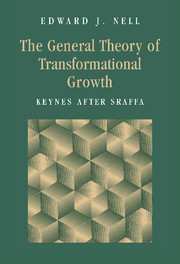Book contents
- Frontmatter
- Contents
- Preface
- Acknowledgments
- Part I History or equilibrium?
- 1 The idea of Transformational Growth
- 2 The stylized facts of the old business cycle and the new
- Part II Method and approach: the active mind
- Part III Money and the Golden Rule
- PART IV The wage-profit trade-off
- Part V Investment and Mass Production
- Part VI Money and fluctuations in the modern economy
- Conclusions
- Bibliography
- Index
2 - The stylized facts of the old business cycle and the new
Published online by Cambridge University Press: 21 January 2010
- Frontmatter
- Contents
- Preface
- Acknowledgments
- Part I History or equilibrium?
- 1 The idea of Transformational Growth
- 2 The stylized facts of the old business cycle and the new
- Part II Method and approach: the active mind
- Part III Money and the Golden Rule
- PART IV The wage-profit trade-off
- Part V Investment and Mass Production
- Part VI Money and fluctuations in the modern economy
- Conclusions
- Bibliography
- Index
Summary
Macroeconomics makes an occasional bow to history and institutions, nothing their importance in understanding policy, particularly in connection with exogenous “shocks.” But the models advanced in most mainstream work, as well as those in contemporary “alternative” schools of thought, tend to be perfectly general. They are not considered specific to any one historical period. Economic behavior and the working of markets are treated as universal, essentially the same, aside from “imperfections,” in all times and places. Economics is grounded in rational choice, expressed most fully in general equilibrium price theory. Macroeconomics can then be derived from this by specifying any of a large number of imperfections or institutional barriers to the smooth adjustment of markets.
General equilibrium theory is abstract and nonempirical. But price theory does not have to take this form. Ordinary textbook microeconomics – supply and demand – offers a strikingly detailed picture of the way markets work, from which a number of plausible empirical propositions can be derived. For example, this picture suggests that when demand fluctuates, prices will fluctuate in the same direction, and the fluctuations will be greater the more inelastic the supply is. Movements in prices will therefore be positively correlated with movements in output. Real wages will be inversely related to employment and output. Increases in productivity will lead to lower prices. The picture has institutional implications as well: firms will grow to an optimal size and operate at that level indefinitely.
- Type
- Chapter
- Information
- The General Theory of Transformational GrowthKeynes after Sraffa, pp. 37 - 70Publisher: Cambridge University PressPrint publication year: 1998



